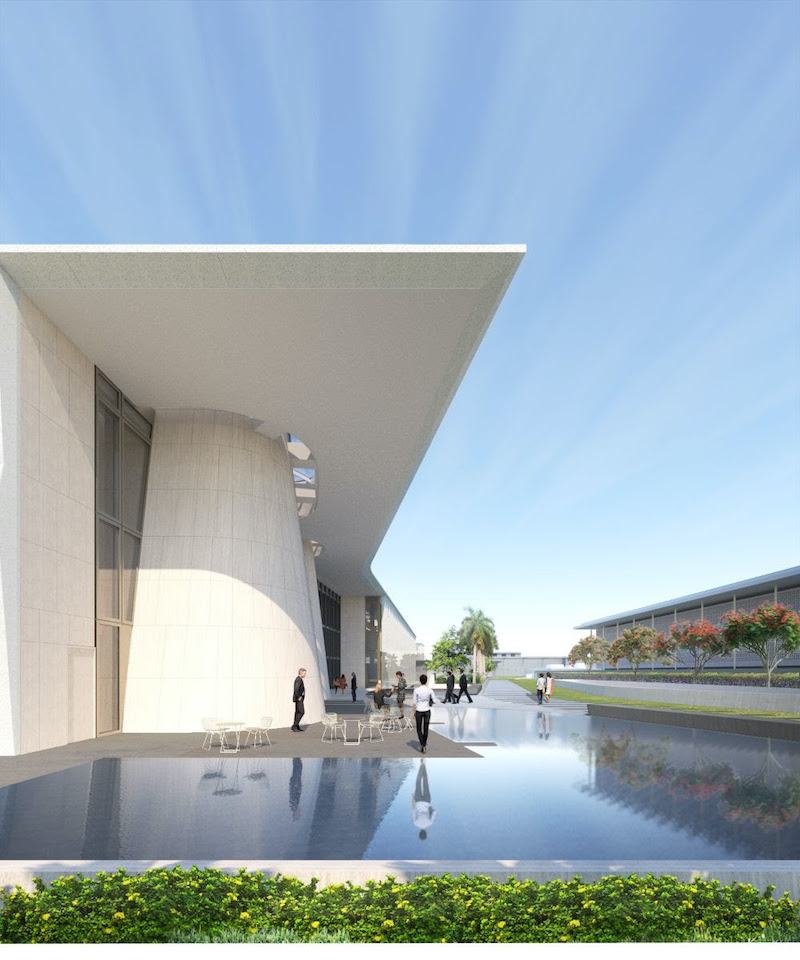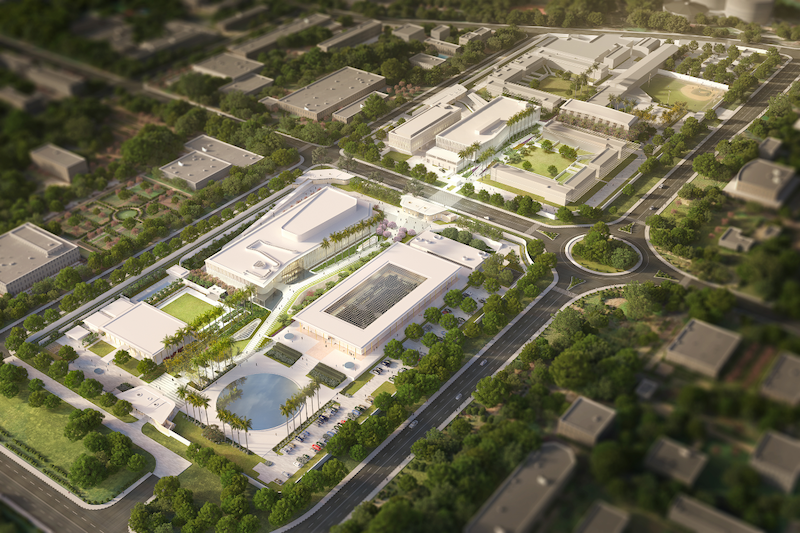Weiss/Manfredi has broken ground on a new chancery building for the U.S. Embassy in New Delhi, India. The long-term project will also include a new office building, a support annex, and a unifying landscape that will provide a secure campus.
A tree-lined promenade will link all the new and existing buildings on the campus, connect functional zones, and introduce reciprocal relationships between buildings and gardens. A series of cast stone screens, canopies, reflecting pools, and garden walls will introduce a resilient, integrated design language.

“Our goal is to create an open, unified campus that is safe and secure,” said architects Marion Weiss and Michael Manfredi, in a release. “To do that, we drew upon traditional Indian garden elements such as walls, screens, moats, and reflecting pools that provide not only a level of security, but also a connection to the great legacy of Indian architecture. The new embassy buildings and gardens reference Edward Durell Stone’s historic chancery, introduce a resilient design language and transform the campus to meet the needs of twenty-first century diplomacy.”
Weiss/Manfredi Architecture/Landscape/Urbanism was selected as the design architect by the U.S. Department of State’s Bureau of Overseas Buildings Operations in 2015. The completion of the entire campus is expected in fall 2027.

Related Stories
| Nov 13, 2013
Installed capacity of geothermal heat pumps to grow by 150% by 2020, says study
The worldwide installed capacity of GHP systems will reach 127.4 gigawatts-thermal over the next seven years, growth of nearly 150%, according to a recent report from Navigant Research.
| Nov 8, 2013
Oversized healthcare: How did we get here and how do we right-size?
Healthcare facilities, especially our nation's hospitals, have steadily become larger over the past couple of decades. The growth has occurred despite stabilization, and in some markets, a decline in inpatient utilization.
| Nov 8, 2013
S+T buildings embrace 'no excuses' approach to green labs
Some science-design experts once believed high levels of sustainability would be possible only for low-intensity labs in temperate zones. But recent projects prove otherwise.
| Nov 6, 2013
PECI tests New Buildings Institute’s plug load energy use metrics at HQ
Earlier this year, PECI used the NBI metrics to assess plug load energy use at PECI headquarters in downtown Portland, Ore. The study, which informed an energy-saving campaign, resulted in an 18 percent kWh reduction of PECI’s plug load.
| Oct 30, 2013
15 stellar historic preservation, adaptive reuse, and renovation projects
The winners of the 2013 Reconstruction Awards showcase the best work of distinguished Building Teams, encompassing historic preservation, adaptive reuse, and renovations and additions.
| Oct 30, 2013
Why are companies forcing people back to the office?
For a while now companies have been advised that flexibility is a key component to a successful workplace strategy, with remote working being a big consideration. But some argue that we’ve moved the needle too far toward a “work anywhere” culture.
| Oct 30, 2013
11 hot BIM/VDC topics for 2013
If you like to geek out on building information modeling and virtual design and construction, you should enjoy this overview of the top BIM/VDC topics.
| Oct 28, 2013
Urban growth doesn’t have to destroy nature—it can work with it
Our collective desire to live in cities has never been stronger. According to the World Health Organization, 60% of the world’s population will live in a city by 2030. As urban populations swell, what people demand from their cities is evolving.
| Oct 18, 2013
Researchers discover tension-fusing properties of metal
When a group of MIT researchers recently discovered that stress can cause metal alloy to fuse rather than break apart, they assumed it must be a mistake. It wasn't. The surprising finding could lead to self-healing materials that repair early damage before it has a chance to spread.
| Oct 18, 2013
Sustainability expert: Smart building technology can have quick payback
Smart building technology investments typically pay for themselves within one or two years by delivering energy savings and maintenance efficiencies.

















